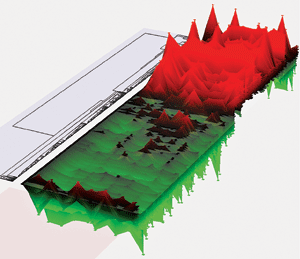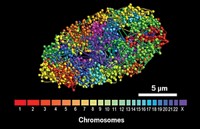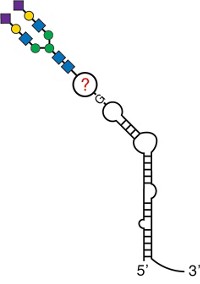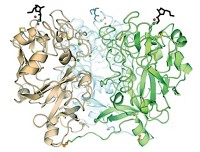Advertisement
Grab your lab coat. Let's get started
Welcome!
Welcome!
Create an account below to get 6 C&EN articles per month, receive newsletters and more - all free.
It seems this is your first time logging in online. Please enter the following information to continue.
As an ACS member you automatically get access to this site. All we need is few more details to create your reading experience.
Not you? Sign in with a different account.
Not you? Sign in with a different account.
ERROR 1
ERROR 1
ERROR 2
ERROR 2
ERROR 2
ERROR 2
ERROR 2
Password and Confirm password must match.
If you have an ACS member number, please enter it here so we can link this account to your membership. (optional)
ERROR 2
ACS values your privacy. By submitting your information, you are gaining access to C&EN and subscribing to our weekly newsletter. We use the information you provide to make your reading experience better, and we will never sell your data to third party members.
Biological Chemistry
Biochem Engineers Meet In Quebec
Engineers combine chemistry and biology to tackle an array of challenges
by Celia Henry Arnaud
August 20, 2007
| A version of this story appeared in
Volume 85, Issue 34

THE DAYS when biochemical engineers cared only about scaling up reactions and purifying the resulting products are long gone. Today, these investigators have a broader range of interests.
Last month, some 250 biochemical engineers gathered in Quebec City to share research results in areas ranging from biofuels to stem cells. The meeting, sponsored by Engineering Conferences International, attracted professionals from 25 countries.
Program chairs Michael Betenbaugh of Johns Hopkins University and Vijay Yabannavar of Seattle-based Trubion Pharmaceuticals designed the lineup, in Betenbaugh's words, "to show the impact that biochemical engineers have at multiple scales, from the molecule all the way to the network and the family of cells."
Here is a smattering of the work that researchers at the conference shared with their colleagues.
Bacterial quantum dot factory
A PRACTICAL biological synthesis for the inorganic nanocrystals popularly known as quantum dots is a step closer to reality. Researchers at the University of California, Riverside, have engineered bacteria to produce quantum dots suitable for biological labeling.

Quantum dots are attractive fluorescent tags for studying biological systems because of their tunable fluorescence characteristics, narrow emission spectra, and resistance to fading. Unfortunately, the most successful chemical synthesis of quantum dots requires harsh conditions. A promising alternative to the usual chemical synthesis is the use of biological templates to guide the synthesis. Most biologically based processes, however, yield quantum dots that are too large to be useful in cellular assays.
Wilfred Chen and coworkers at UC Riverside may have found a solution to that problem. They have programmed Escherichia coli that consistently deliver quantum dots about 5 nm in diameter.
The engineered bacteria use a peptide called phytochelatin to guide the synthesis. This peptide—which is synthesized from the tripeptide glutathione—is usually made by plants and yeast to defend against heavy-metal toxicity. Chen programs the bacteria to make the enzyme phytochelatin synthase, which catalyzes the production of the peptide.
The phytochelatin noncovalently binds cadmium ions and serves as a nucleation site for the nanoparticles. Cadmium sulfide (CdS) nanocrystals form when sodium sulfide (Na2S) is added to the culture medium. The researchers harvest the particles by breaking the cells open. In addition, the phytochelatin plays a second role as a capping agent that prevents aggregation of the particles. The size of the quantum dots can be tuned by using phytochelatins with different numbers of glutathione units.
Chen would like to gain more control over the amount of sulfide in the quantum dots. "It's difficult to control the cadmium-sulfide ratio in the nanoparticles," he said. "That's a very important parameter in controlling the quality of the nanocrystal." It's hard to tell how much of the sulfide actually reaches the cells and is internalized by them. Chen plans to give the bacteria a way to provide their own supply of sulfide by adding the enzyme cysteine desulfhydrase, which converts the amino acid cysteine to H2S.
Chen aims to demonstrate that he can make other kinds of quantum dots using engineered bacteria. Industrially, the most important quantum dots have a CdSe core inside a ZnS shell. "We probably have to add dual functionality to the peptide," he said. "We'll be able to differentially bind cadmium and zinc, so it can actually define a core and shell synthesis."
Slowing protein translation leads to more protein secretion
ON ITS OWN, Escherichia coli secretes only a few proteins beyond its outer membrane. If the bacterium can be induced to release a desired protein, purification is simple because of the lack of other proteins in the mix. But the cells don't really like to secrete proteins, so it's hard to get large quantities of the biomolecules. It turns out that one way to get the bacteria to secrete more protein may be to slow down protein synthesis in the microbes.
Some E. coli have machinery, known as the hemolysin secretion pathway, that allows them to secrete proteins (usually the toxin α-hemolysin) through their cell membrane. A signal peptide attached to the target proteins flags them for the machinery. The strains of E. coli that are used for making recombinant proteins don't naturally have the secretion machinery, so the genes for making it must be added. Kelvin Lee's group at Cornell University started with hemolysin-secreting E. coli, randomly mutated them, and screened for mutants that secreted larger amounts of the α-hemolysin.
At first, they couldn't figure out what made the supersecreting mutants so good. But analysis of messenger RNA and protein expression data revealed that these mutants had smaller amounts of transfer RNA synthetases, the enzymes that attach amino acids to their corresponding tRNA during protein synthesis. This reduced supply of tRNA synthetase slows down protein synthesis by restricting the available pool of loaded tRNAs.
This finding hinted that the translation rate might be the key. Rather than playing with the enzyme, Lee slowed down translation by changing the DNA sequence encoding the target protein to which the hemolysin signal peptide is fused. He switched a handful of the regular codons, the DNA triplets that encode amino acids, for rarer codons that signify the same amino acid but for which the cell has a lesser supply of corresponding tRNAs. Such synonymous substitutions don't change the final product, just how quickly it's made.
"We looked for codons that we estimated would have a reasonably large impact" on the translation rate, Lee said. He worried that changes near the ends of the protein could cause problems, so he restricted his tinkering to the middle of the protein.
How much is enough when it comes to the changes? "It's clear that there must be an optimum," Lee said. "We know some of the factors, but it's not obvious how to control this completely."
Lee's group has progressed from hemolysin to other model proteins, including interleukin-6, antibody fragments, and other molecules, each of which can be secreted through the hemolysin pore.
Systems biology fingers Nitric oxide target

NITRIC OXIDE is a multitasking molecule. One of its many roles in mammalian systems is as a defense against bacteria. But what does NO target in bacteria to slow their growth? James Liao and coworkers at the University of California, Los Angeles, used systems biology to tackle that question.
Detective work combining microarray data and mathematical analysis revealed that the relevant NO target is the enzyme dihydroxyacid dehydratase (DHAD), which is involved in the branched-chain amino acid synthesis pathway (Proc. Natl. Acad. Sci. USA 2007, 104, 8484).
The researchers' goal was to uncover the entire bacterial NO response network. "It's very important to develop a systems biology approach to understand how such a complicated network works," Liao said. "Nitric oxide interaction with bacteria provides a convenient example."
Liao started with DNA microarray analysis of the genes in Escherichia coli to see what transcription factors were perturbed by NO. "Some genes are controlled by multiple transcription factors," Liao said, so the microarray analysis by itself wasn't enough.
The researchers simplified the microarray data using a mathematical technique called network component analysis (NCA), which takes into account the known connections between genes and transcription factors. "This method basically separates the transcription factor activity from its own transcript abundance," Liao said.
The mathematical analysis told the researchers that only 13 of E. coli's transcription factors are perturbed by NO. A closer look at the chemistry of those transcription factors revealed that only three of those 13 have appropriate functionality—either an Fe or Fe-S center—to interact with NO directly. To figure out what sorts of indirect effects might be perturbing the other 10 transcription factors, Liao and his colleages identified other bacterial proteins that could interact with NO.
By combining the mathematical analysis with biochemical experiments, they concluded that NO targets DHAD. This pathway is common to bacteria but is not found in humans.





Join the conversation
Contact the reporter
Submit a Letter to the Editor for publication
Engage with us on Twitter